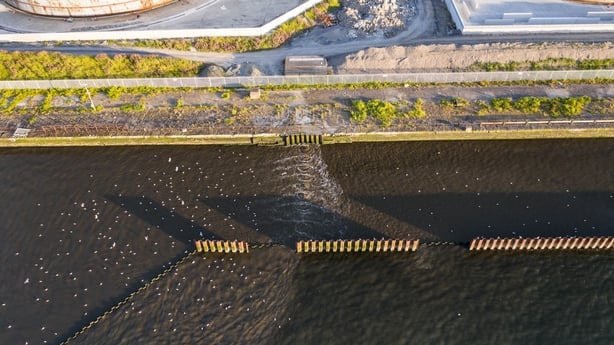The largest phosphorus extraction reactor in Europe has been installed at the Ringsend Wastewater Treatment Facility in Dublin.
Úisce Éireann says it will result in more environmentally sustainable wastewater treatment and protecting the waters of the lower Liffey estuary and Dublin Bay.
The phosphorus is being turned into fertiliser to help grow food and crops.
Around 40% of all Ireland's sewage currently flows into the Ringsend Wastewater Treatment Facility in Dublin.
It arrives, 24 hours per day, seven days a week, in a stinking stream at a typical flow rate of ten cubic metres per second.
It is a huge job to clean it up, especially since the plant at Ringsend is simply not big enough for the population it serves.
A €500m facilities upgrade is well under way and as part of that the largest phosphorus processing reactor in Europe has been installed.
The reactor is now up and running, extracting something very valuable from the wastewater that flushes away.
Phosphorus is a finite resource. It has real value in agriculture and other sectors including gardening as a fertiliser product.
But when it is released into aquatic environments like river estuaries and the sea it can cause significant ecological and environmental damage.
It encourages the growth of algae blooms with very bad consequences for water quality and aquatic life.
This has always been a big issue for the lower Liffey estuary, a nutrient-sensitive aquatic environment, into which the treated outflow of the Ringsend plant is released.
Jean Hobbs, Senior Programme Manager at Úisce Éireann overseeing the Ringsend upgrade, says phosphorus and other nutrients in treated wastewater (such as nitrogen) are bad for the Liffey estuary.
"We are now taking up to 85% of the phosphorus from the wastewater stream and recovering it. We are turning it into a valuable resource that is going back to farmers and gardeners for use on the land", she says.
The recovered phosphorus produced at Ringsend is pure. It forms into clean, pearly-coloured, rounded granules that look very similar to most of the fertiliser products gardeners are used to seeing in garden centres and similar stores. It can safely be spread on land to help crops and plants to grow.
Over a period of 90 weeks Patrick Maguire, Project Director at Murphy Ireland, oversaw the construction of the phosphorus extraction facility.

He says building it while the wastewater treatment plant was operating at full capacity was like having to change the tyre on a car while driving at full speed.
"This is the first time phosphorus is being extracted from wastewater in Ireland. It is a key part of the circular economy because the recovered materials can be fed back to the agricultural sector."
There are three main ingredients in the fertiliser granules produced at Ringsend - phosphorus, ammonia, and magnesium oxide.
Material from wastewater sludge provides all the phosphorus and ammonia required.
However, the magnesium oxide is extra. It must be added into the mix from a silo on-site.
This mixture then goes through a crystallisation process in the large reactor which causes it to form into granules.
When those granules grow large enough, they are harvested, put through a drying process, before being bagged to be sold off.
Ms Hobbs says that at full capacity the plant will be capable of producing 14 tonnes of phosphorus granules per day.
With fertiliser prices currently sky high this could prove to be a very valuable and useful by-product of wastewater treatment in Ireland.
The phosphorus reactor installed at Ringsend is now the largest such reactor by volume operating in Europe.
In fact, according to Mr Maguire, there are no larger phosphorus reactors in operation anywhere in the world.
It is so big that it could not be transported by road in one piece. Instead, it was built and transported in three segments before being assembled on site.
Ms Hobbs says the phosphorus extraction facility is a small but important part of the €500m investment that Úisce Eireann is putting into the Ringsend plant.
She says: "We are also upgrading our existing 24 secondary wastewater treatment tanks. Also, in recent years we have built what we call "a capacity upgrade facility" from scratch, on a brownfield site here".
That upgrade, on its own is treating the wastewater from a population equivalent of 400,000 people. If it had been built in a different location, it would be the second-largest wastewater treatment plant in Ireland after Ringsend itself.
Currently, the Ringsend Wastewater Treatment Facility falls short of compliance with the EU Wastewater Treatment Directive. The phosphorus extraction facility is a relatively small but important part of the essential improvements needed.
Ms Hobbs says the overall facility should be hitting compliance by the end of this year for a population of 2.1 million people. "Everything about the plant is vast" she says.
"It is doing its job but it will be doing it even better by the end of 2025 and when the whole plant upgrade is completed it should be capable of dealing with the wastewater from a population equivalent of 2.4 million people."






